Stir-fried clams, a beloved dish in many coastal cuisines, are celebrated for their briny sweetness, tender texture, and ability to absorb vibrant flavors. Whether served as an appetizer, a main course, or a street food snack, this dish has captured the hearts of food enthusiasts worldwide. However, achieving the perfect balance of flavor, texture, and aroma requires precision, attention to detail, and an understanding of the ingredients involved. This comprehensive guide will walk you through every step of creating a memorable stir-fried clam dish, from selecting the freshest shellfish to mastering the cooking technique that ensures each clam is cooked to perfection.
The Allure of Stir-Fried Clams
Stir-fried clams, often referred to as “爆炒花蛤” in Chinese cuisine, are a testament to the beauty of simplicity. The dish typically features clams cooked briefly in a scorching-hot wok with aromatics like garlic, ginger, and chili, along with a combination of sauces that elevate the natural taste of the shellfish. What makes this dish so captivating is its contrasting elements: the smoky heat from the wok, the pungent kick of garlic and chili, the umami-rich depth of soy sauce or oyster sauce, and the refreshing finish of herbs like cilantro or green onions.
The appeal of stir-fried clams lies not just in their taste but also in their versatility. They can be adapted to suit various palates—spicy, mild, savory, or even tangy with a splash of lime. Additionally, the dish is relatively quick to prepare, making it an ideal option for busy weeknights or impromptu gatherings. Yet, despite its simplicity, achieving restaurant-quality results at home requires adherence to a few key principles.
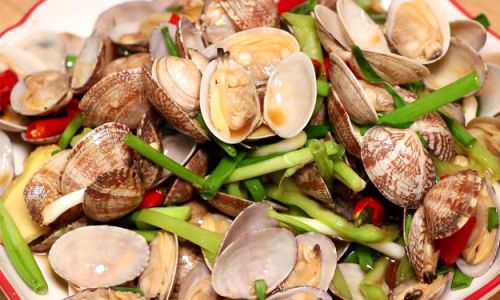
Selecting the Freshest Clams
The foundation of any great stir-fried clam dish is the quality of the clams themselves. Freshness is non-negotiable, as stale or spoiled shellfish can ruin the dish and pose health risks. When shopping for clams, look for specimens that are tightly closed, with shells free of cracks or chips. Avoid clams that remain open when tapped gently, as this indicates they may already be dead.
Clams are often sold live, either in bags or displayed on ice. If purchasing from a fishmonger, ask when the clams were harvested—ideally, they should be as recent as possible. Some markets also offer pre-cleaned clams, but it’s always wise to inspect them yourself.
Storage Tips:
If you’re not cooking the clams immediately, store them in a breathable container (like a mesh bag) in the refrigerator. Place a damp cloth over them to maintain humidity, but avoid submerging them in water, as this can drown the clams.
Preparing the Clams: Cleaning and Purging
Even the freshest clams may contain sand or grit, which can ruin the texture of the dish. Proper cleaning and purging are essential to ensure a pleasant eating experience.
-
Soaking in Saltwater:
Fill a large bowl with cool water and dissolve 1/4 cup of kosher salt or sea salt per gallon of water. Submerge the clams in this brine and let them soak for 1–2 hours. This encourages the clams to expel any sand trapped inside their shells. -
Scrubbing the Shells:
After soaking, scrub each clam under cold running water with a stiff brush to remove any mud, barnacles, or debris from the shells. -
Discarding Unhealthy Clams:
As you clean the clams, discard any that remain open after a firm tap or those with broken shells. These are signs of spoilage and should not be consumed.
Essential Ingredients for Flavor
The beauty of stir-fried clams lies in their ability to shine with minimal ingredients. However, the right combination of aromatics, sauces, and seasonings can transform them into a culinary masterpiece. Here’s a breakdown of the key components:
-
Aromatics:
- Garlic: Mince or slice 6–8 cloves for a pungent, aromatic base.
- Ginger: A 1-inch piece of fresh ginger, julienned or grated, adds warmth and depth.
- Chili: Fresh or dried chilies (to taste) provide heat. Serranos, jalapeños, or Thai bird’s eye chilies work well.
- Shallots or Onions: Thinly sliced shallots or red onions add sweetness and texture.
-
Sauces and Seasonings:
- Soy Sauce: Light soy sauce for saltiness; dark soy sauce for color (optional).
- Oyster Sauce: A tablespoon adds umami and richness.
- Fish Sauce: A splash enhances savoriness (use sparingly).
- Sesame Oil: A drizzle at the end adds nutty aroma.
- Rice Wine or Shaoxing Wine: Deglazes the pan and imparts complexity.
-
Optional Additions:

- Cilantro or Basil: Chopped herbs for freshness.
- Green Onions: Sliced diagonally for garnish.
- Lemon or Lime Wedges: A squeeze of citrus brightens the dish.
The Cooking Process: Wok Hei and Timing
Stir-frying clams is a rapid, high-heat process that requires focus and precision. The goal is to cook the clams just until they open, ensuring they remain tender and juicy. Overcooking will result in rubbery, chewy clams, while undercooking leaves them raw and gritty.
-
Preheat the Wok:
Heat a wok or large skillet over high heat until it begins to smoke. Add 2–3 tablespoons of neutral oil (like vegetable or peanut oil) and swirl to coat the pan. -
Sauté Aromatics:
Add the garlic, ginger, and chili to the hot oil. Stir-fry for 10–15 seconds until fragrant but not browned. Burnt garlic will impart a bitter taste, so move quickly. -
Add the Clams:
Toss the cleaned clams into the wok. Stir vigorously to coat them in the aromatics and oil. -
Deglaze with Wine:
Pour in 2–3 tablespoons of rice wine or Shaoxing wine. The alcohol will evaporate quickly, leaving behind a subtle sweetness. -
Season and Cover:
Add the soy sauce, oyster sauce, and a pinch of white pepper. Stir to combine, then cover the wok with a lid. Let the clams steam for 2–3 minutes, or until the shells begin to open. -
Uncover and Finish:
Remove the lid and discard any clams that remain closed. Add a splash of sesame oil and toss in the cilantro or green onions. Stir-fry for another 30 seconds to meld the flavors.
Serving Suggestions and Pairings
Stir-fried clams are incredibly versatile and pair well with a variety of accompaniments:
- Steamed Rice: The classic choice, as it soaks up the flavorful juices.
- Noodles: Toss the clams and sauce with egg noodles or rice vermicelli for a heartier meal.
- Crusty Bread: Perfect for mopping up the broth in Western-style presentations.
- Salads: Serve over a bed of greens with a tangy vinaigrette for a refreshing contrast.
For a complete meal, pair the clams with light sides like stir-fried bok choy, cucumber salad, or pickled vegetables.
Troubleshooting Common Issues
Even seasoned cooks encounter hiccups in the kitchen. Here’s how to address common problems when making stir-fried clams:
-
Clams Don’t Open:
Discard any clams that remain tightly shut after cooking, as they may be unsafe to eat.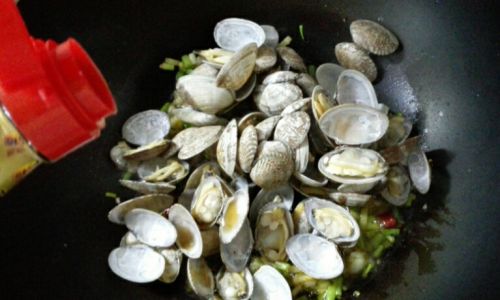
-
Sandy Texture:
Ensure thorough purging in saltwater. If grit remains, rinse the clams again before cooking. -
Overcooked Clams:
Remove the clams from the heat as soon as the shells open. Residual heat will continue cooking them slightly. -
Lack of Flavor:
Adjust seasonings gradually. Taste the sauce before adding the clams and adjust saltiness, spice, or acidity as needed.
Variations and Creative Twists
While the traditional recipe is a crowd-pleaser, don’t hesitate to experiment:
- Spicy Thai-Style: Add lemongrass, kaffir lime leaves, and a splash of coconut milk.
- Mediterranean Flair: Substitute soy sauce with tomato paste, add olives, and garnish with feta.
- Vegan Option: Use mushroom-based “oyster” sauce and omit fish sauce. Add diced tofu or tempeh for protein.
- Herbaceous Finish: Toss in a handful of basil or mint leaves during the final stir.
The Science Behind Perfect Stir-Fried Clams
Understanding the science of cooking can elevate your technique:
- Wok Hei: The “breath of the wok” refers to the smoky, charred flavor imparted by high-heat cooking. Achieving this requires a well-seasoned wok and intense heat.
- Maillard Reaction: The brief sear on the clams and aromatics creates complex flavors through caramelization.
- Emulsification: The brief steaming process helps the sauces cling to the clams, creating a glossy, cohesive coating.
Cultural Significance of Clams in Cuisine
Clams have been a dietary staple for millennia, revered in coastal cultures for their abundance and nutritional value. In Chinese cuisine, clams symbolize wealth and prosperity, often served during festivals and celebrations. Similarly, in Italian and Portuguese traditions, clams are central to seafood stews and pasta dishes, reflecting their deep connection to maritime heritage.
Conclusion: The Joy of Stir-Fried Clams
Mastering stir-fried clams is a rewarding journey that blends technique, creativity, and respect for ingredients. Whether you prefer them fiery and bold or delicate and aromatic, the key lies in balancing freshness, flavor, and fire. With practice, you’ll learn to anticipate the sizzle of the wok, the aroma of garlic, and the moment when the clams open to reveal their tender flesh—a culinary triumph that never fails to impress.
So, the next time you crave a dish that’s both humble and extraordinary, reach for a bag of clams, fire up your wok, and let the magic unfold. Your taste buds—and your guests—will thank you.

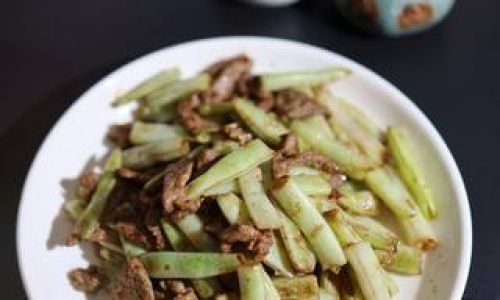
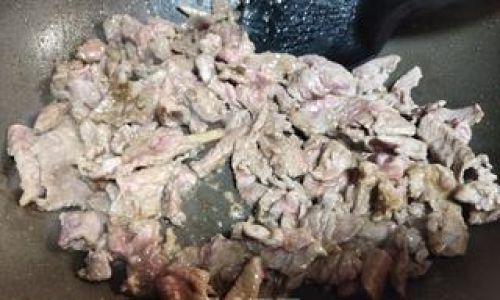
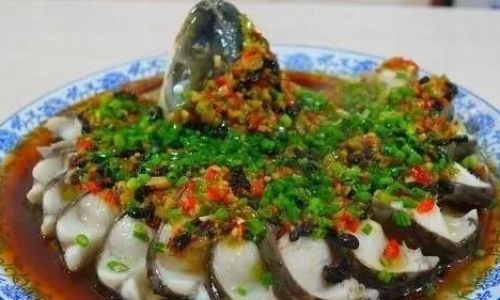

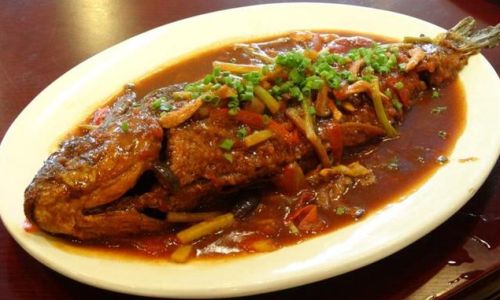
0 comments